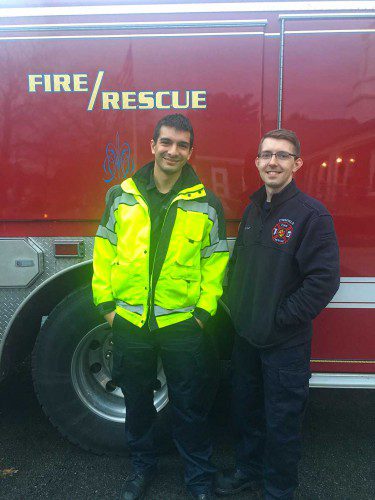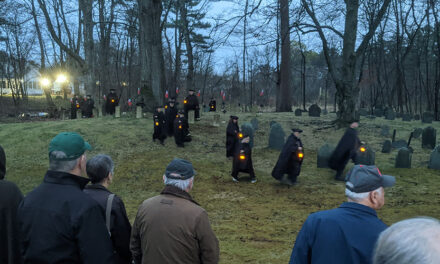Published in the January 11, 2017 edition

THE FIRE DEPARTMENT’s new career firefighters are Christopher Cavalieri (left) and Matthew Nichols. The firefighters began their tenure at the department last week. (Lynnfield Fire Department Photo)
By DAN TOMASELLO
LYNNFIELD — The Lynnfield Fire Department has begun a new era in a new year.
After three years in the making, the Fire Department implemented its new staffing model last week. During last April’s Town Meeting, townspeople approved overhauling the way the Fire Department is staffed. The department has added two career firefighters to its current staff of permanent and call firefighters in order to provide coverage 12 hours per day, seven days per week.
As part of the new system, the Fire Department’s hours are now 6:30 a.m. to 6:30 p.m. seven days per week. The Fire Department’s old shifts were 8 a.m. to 4 p.m. Monday through Thursday, and 8 a.m. to 4:30 p.m. on Friday.
Fire Chief Mark Tetreault said he’s pleased the Fire Department has finally made some long overdue changes.
“It was a long process and we had some obstacles to overcome with the collective bargaining agreement, but we all came together in the end to make this work,” said Tetreault in an interview with the Villager.
Tetreault said the Fire Department’s old staffing model was originally implemented in 1971, when the department transitioned from a completely on-call Fire Department to a combination career and call department.
“Since 1971, we staffed the station eight hours a day, five days a week,” said Tetreault. “That model worked pretty well until about five years ago. It started to get busier when we took over the ambulance, and we are now doing over 1,800 calls a year. It’s just not the same as it was in 1971.”
According to Tetreault, the Fire Department was asking both call and permanent firefighters to respond to emergency situations during off hours. He said the system was taking its toll.
“It became very taxing for firefighters after awhile,” said Tetreault. “(Permanent firefighters) would work an eight-hour day, get called back and wouldn’t get home until 6 or 7 o’clock at night. Call firefighters could immediately get called as soon as they got home from work. It became quite burdensome and also became expensive because when we are calling our career staff back, they get overtime. We are not begrudging anyone who wants to make a dollar, but it’s not cost effective.”
Tetreault said the Fire Department examined what portions of the day they received the most calls and determined about 75 percent of them occurred between 6:30 a.m. and 6:30 p.m.
“We said if we could staff the station during that time period, we would not be calling back as often,” explained Tetreault. “We can now immediately go out on a call instead of having people come from their house, come to the fire station, get in a fire truck and go. Our response time is much better.”
Tetreault also said the Fire Department’s new staffing model is less stressful for firefighters and is more cost effective.
“It reduces the stress on the firefighters and we are not spending as much on overtime,” said Tetreault.
In order to implement the new staffing model, the Fire Department has added two permanent firefighters. They are firefighter/EMT Matthew Nichols and firefighter Chris Cavalieri. Both were previously call firefighters.
“With the new collective bargaining agreement, you have to be a paramedic within two years of being hired,” said Tetreault. “Matthew is already a paramedic and Chris is about halfway there. A paramedic can do a lot more on the ambulance, especially with advanced life support and administering medications, so we want paramedics. We are adding two more career paramedics to our staff, which is a good thing.”
Additionally, Tetreault said the Fire Department is utilizing four full-time equivalent (FTE) firefighters, which he explained are “call firefighters who come in and work at the fire station on their days off from their full-time jobs.”
“The full-time equivalent positions rotate through our call firefighters,” said Tetreault. “The idea is to continue to engage our call firefighters and better integrate them into the day to day operations of the department.”




